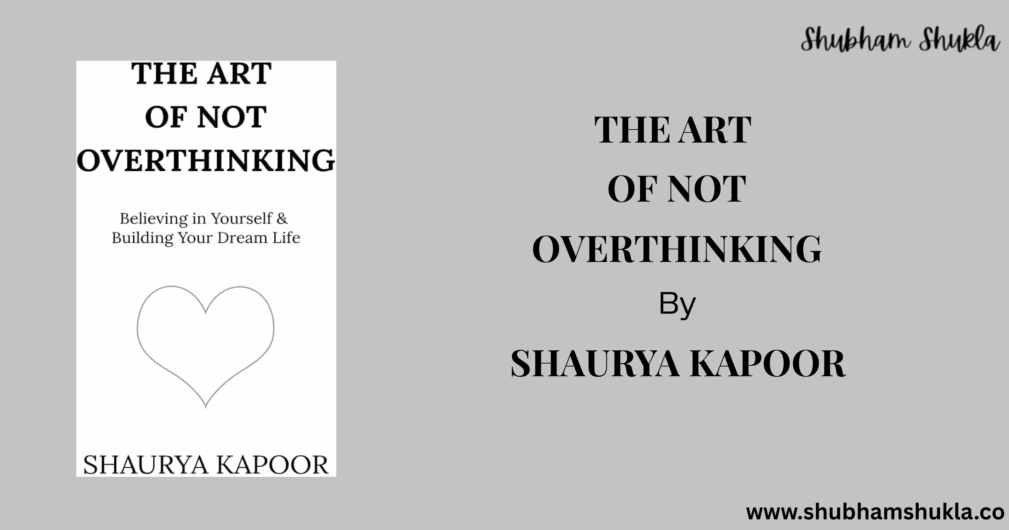In today’s fast-paced world, overthinking has become a widespread problem, resulting in worry, indecision, and a lower quality of life. Shaurya Kapoor’s The Art of Not Overthinking: Believing in Yourself and Creating Your Dream Life is a compassionate and practical guidance for breaking free from the bonds of obsessive ruminating.
Kapoor encourages readers to nurture self-belief, embrace mindfulness, and take bold action toward a more satisfying life by using relevant anecdotes, actionable ideas, and a pleasant, conversational tone.
Let’s Understand Overthinking
Kapoor begins by analyzing overthinking, describing it as a mental loop driven by anxiety, self-doubt, and a craving for control. He underlines that overthinking is frequently caused by deeper emotional triggers such as prior traumas, a fear of failure, and cultural expectations. By recognizing these underlying issues, readers can start to address the source of their overthinking habits.
Read: 15 Romantic Aadvika Pommu Novels That Will Steal Your Heart
Key Lessons
Being Self-Aware and Recognizing Triggers
Kapoor emphasizes the importance of self-awareness in overcoming overthinking. He encourages readers to reflect on moments when their minds spiral out of control and identify specific triggers. Individuals who write or meditate on these occurrences can identify patterns and try to break the cycle of overanalysis.
The Influence of Making a Decision
One of the book’s fundamental principles is that “action reduces anxiety.” Kapoor contends that overthinking thrives in inaction, and that taking even little efforts can break the pattern. He proposes establishing “decision deadlines” to encourage timely action and decrease mental clutter.
Read: Book Review – From ML Algorithms to GenAI & LLMs
Changing to a Mindset Focused on Solutions
Instead of dwelling on issues, Kapoor invites readers to concentrate on solutions. Ask questions like, “What’s the next best step I can take?” Individuals can refocus their thinking toward positive outcomes, lowering anxiety and encouraging a proactive attitude to obstacles.
Giving Up Things You Can’t Control
The book provides an important lesson: focus solely on what you can manage. Overthinking typically involves stressing over external factors—what others think, unexpected repercussions, or past events. Kapoor teaches readers mindfulness methods including deep breathing and grounding exercises to help them return to the present moment.
Defining Limits and Refusing to
Kapoor analyzes the relationship between overthinking and people pleasing. He claims that saying “yes” to everyone might lead to emotional exhaustion and constant second-guessing. Individuals can reduce the mental strain that causes overthinking by establishing reasonable boundaries and emphasizing their own well-being.
Read: In the Silence You Left Behind a Book by Sumitra Manda
Simplifying Your Life
A crowded mindset is usually the outcome of a busy environment. In order to reduce mental strain, Kapoor suggests minimizing one’s surroundings, responsibilities, and internet habits. By clearing their mental and physical environments, people can become more focused and clear-headed.
You may also read: 10 Essential Types of Characters in Literature (With Examples)
Writing Style and Structure
Kapoor’s writing style is distinguished by its simplicity and relatability. The book is divided into four chapters, “You Deserve Love,” “You Deserve Happiness,” “You Deserve Peace,” and “You Deserve Healing.” Each segment blends inspiring language with practical guidance, making it suitable for a wide spectrum of readers. The conversational tone feels like advice from a close friend, providing comfort and support along the way.
Reaction of Readers
Positive reviews have been given to the book because of its emotional relevance and realistic approach. It has been described by readers as a “pep talk” and a “warm hug” that provides consolation in emotionally trying moments. A lot of people choose self-compassion and practical answers. Others, however, have remarked that the book’s formatting—which includes large letter sizes and lots of white space—and its conciseness might not offer enough information for readers seeking a comprehensive analysis of the topic.
Read: Think and Grow Rich Summary: Key Lessons and Takeaways
Final Thought
For those who want to escape the bonds of excessive rumination, The Art of Not Overthinking is a gentle yet effective manual. Through self-awareness, taking decisive action, and developing self-belief, Kapoor gives readers the skills they need to deal with mental complexity and live a more contented, meaningful life.
The book’s strength is its approachability and the emotional bond it creates with readers, even though it might not go into great detail about psychological ideas. For individuals ensnared in the maze of overthinking, Kapoor’s observations provide a route to self-empowerment, clarity, and resilience.



